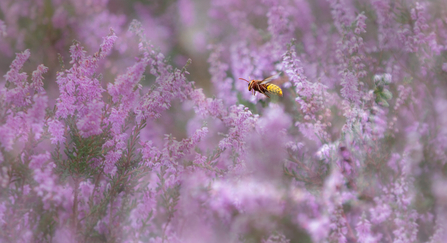We all know that woodland plays a very important role in carbon capture but open habitats such as lowland heathland and meadows also play a vital role. After the sea, our soils are the largest carbon sink on the planet and, particularly where soil is largely undisturbed, carbon stocks build up over time to substantial levels. In Britain, traditionally-managed meadows and heathland that haven't been ploughed or dug for a long time hold on to a lot of carbon. We're only really just beginning to understand the processes involved.
The value of open heathland
Volunteers at The Devil's Spittleful by Wendy Carter

Hornet - Jon Hawkins – Surrey Hills Photography
The biodiversity and climate crisis are inextricably linked. As habitats degrade, they lose the ability to do things that we value, such as holding back excess water. Heathland plants like heather have very extensive root systems that lock in carbon from photosynthesis as well as help to prevent the soil from being eroded away in heavy rain and wind.
But it's not just about carbon and erosion; heathlands and meadows can have a greater variety of flowering plants than a native woodland and these are crucial in supporting our native pollinators: the bees, moths, butterflies, beetles and so on that are vital to pollinate our food crops as well as ensuring native plants continue to thrive.
Natural habitats are never a monoculture of a single species of plant or animal and whilst humans have managed what are now nature reserves for hundreds of years, they're still full of diversity. And whilst we may see myriad bees, wasps, butterflies, birds and more, what they see are a mix of bare earth, hollow stems, tussocky areas, bases of plants and more in which to nest and overwinter. All of these are readily found in open habitats like heathlands - bare sandy areas in which to dig, bases of tussocky heather to hide amongst, dense shrubs like gorse to build nests in.
Trainee Jess scattering heather seed at Dropping Well Farm
At Dropping Well Farm, we're restoring lowland heathland. It will take many years but the journey is as important as the final destination. Guided by archives and maps, which show these fields as heathland within living memory, we've been moving seed and squares of turf from the adjacent established heath at The Devil's Spittleful. In just four to five years we've seen the landscape change significantly; gone is the monoculture of wheat and in its place there's a variety of grasses, flowering plants and shrubs taking hold. Wild pollinators, birds and mammals are seen regularly and it's a joy to watch the changes unfurl. It will take many years for the carbon stocks to fully regenerate but the process is well underway.


